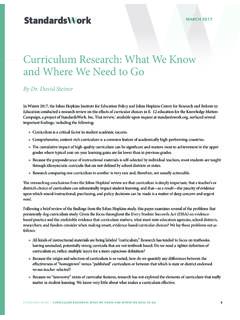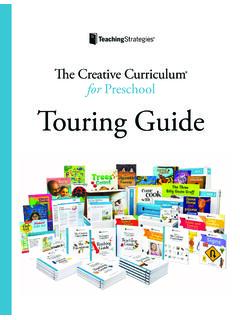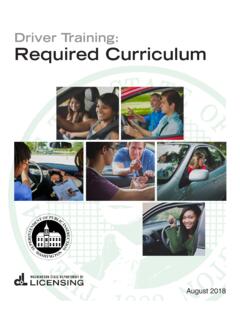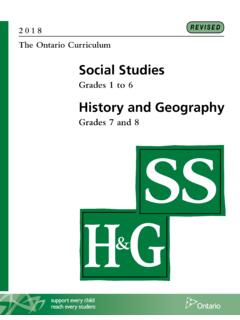Transcription of Research for education inspection framework
1 education inspection framework Overview of Research This paper presents the Research evidence underpinning the education inspection framework . The review draws on a range of sources, including both our own Research programme and a review of existing evidence bases. The review is structured to provide the evidence base that underlies each of the four key judgements for the proposed new framework : quality of education , personal development, behaviour and attitudes, and leadership and management. Published: January 2019. Reference no: 180045. Contents Introduction 3. Overview of Research feeding into the EIF 4. 1. Quality of education 4. Research on the curriculum 4. Research on teacher subject knowledge and support 10. Research on effective teaching 13. Research on memory and learning 19. Research on assessment 22. Research on reading 24. 2. Behaviour and attitudes 29. Research on high expectations and creating a positive culture 29. Research on attendance and attainment 31.
2 Research on behaviour and attainment 32. Research on bullying and discrimination 35. 3. Personal development 37. Research on self-belief, resilience and character 37. Research on physical and mental health 40. Research on citizenship 42. In summary 43. 4. Leadership and management 43. Research on vision and a focus on the quality of education 44. Research on off-rolling 49. Research on parental and community engagement 50. Research on staff well-being 52. 55. education inspection framework : overview of Research January 2019, No. 180045 2. Introduction As Her Majesty's Chief Inspector (HMCI) has stated, we are committed to ensuring that our new education inspection framework (EIF) is informed by Research evidence. This aim has underpinned the whole process of our framework development and has been supported both by reviews of existing Research and by conducting our own Research into areas such as the curriculum . In this paper, we have summarised this work, explaining exactly what evidence on effective practice in schools and early years providers underpins the EIF criteria.
3 The review therefore maps onto the framework criteria, and a large proportion of the Research , for example on the importance of high expectations and vision in leadership, applies across remits. However, there is also a proportion of material that relates specifically to schools or early years. Where this is the case, we will set this out in the text (the relevant remit will be stated in bold). The review draws on a range of sources. HMCI has commissioned a programme of Research from our Research and Evaluation team, much of which has fed directly into the development of the framework . Sources of evidence include our Research on curriculum and teacher well-being, which are summarised in this document in relation to the criteria which they have informed. In addition to our own Research , we have reviewed Research related to the four key inspection judgements: quality of education ; behaviour and attitudes; personal development; and leadership and management.
4 We have drawn on the academic Research literature, but also on Research and guidance from the education Endowment Foundation, the Department for education (DfE), and our own Research and guidance reports. One thing to note is that the Research reviewed here is in large part drawn from that done in schools and early years settings, rather than in further education and skills (FES) providers. This is largely due to the relative paucity of Research in FES compared with the other sectors, and it may mean that not all of the Research reviewed applies equally to FES. We have attempted to summarise the evidence comprehensively, though we have not surveyed the whole field of educational Research , limiting our review to what evidence is directly related to our inspection judgements and criteria. Of course, educational Research is contestable and contested, and so are Research summaries such as this one. We hope, however, that publishing our evidence base will provide transparency, both on the evidence we have consulted and how we have interpreted that evidence.
5 This is not the end of our Research work in relation to the framework . We are also looking at our methods of inspection , not least lesson observation and work scrutiny, and we will be publishing our findings on these before the end of the consultation period. education inspection framework : overview of Research January 2019, No. 180045 3. Overview of Research feeding into the EIF. This overview presents a summary of the Research evidence underlying the key judgement areas in the EIF. The review draws on a range of Research conducted by Ofsted's Research team: a review of the international educational effectiveness Research base a programme of Research on curriculum a study on teacher well-being a study on managing challenging behaviour. The review is structured to provide the evidence base that underlies each of the four key judgements for the proposed new framework : quality of education , personal development, behaviour and attitudes, and leadership and management.
6 1. Quality of education EIF grade criteria: Leaders adopt or construct a curriculum that is ambitious and designed to give learners, particularly the most disadvantaged, the knowledge and cultural capital they need to succeed in life. 1. The provider's curriculum is coherently planned and sequenced towards cumulatively sufficient knowledge and skills for future learning and employment. The provider has the same academic, technical or vocational ambitions for almost all learners. Where this is not practical for example, for some learners with high levels of special educational needs and/or disabilities (SEND) their curriculum is designed to be ambitious and to meet their needs. Learners study the full curriculum . Providers ensure this by teaching a full range of subjects for as long as possible, specialising' only when necessary. Research on the curriculum Our working definition of curriculum is that it is a framework for setting out the aims of a programme of education , including the knowledge and skills to be gained at each stage (intent); for translating that framework over time into a structure and narrative, within an institutional context (implementation); and for evaluating what knowledge and understanding students have gained against expectations (impact).
7 The curriculum 1. The term learners' is used for expediency throughout this document to encompass in a single word those attending education , skills and registered early years settings. It should be read as including: children' in early years provision, pupils' in all schools, students' in sixth forms and colleges, and apprentices', trainees' and adult learners' in the range of further education and skills providers. Greater distinction is made where the Research is focused on a specific sector. education inspection framework : overview of Research January 2019, No. 180045 4. lies at the heart of education . It determines what learners will know and be able to go on to do by the time they have finished that stage of their education . curriculum matters, as it defines the knowledge and experiences that learners will receive beyond their home environment. To this extent, what is taught and how, 2 and who is included, 3 appear to be key principles of curriculum design.
8 Biesta argues that a lack of attention to the aims and ends of education has led to a reliance on a common sense' view of education . 4 A focus on academic achievement in a small number of curriculum domains or subjects is one example of the common sense approach. In schools, there is evidence of curriculum narrowing. International evidence indicates that a focus on only a few measurable outcomes has had some negative consequences for curriculum design. As a result, pupils from disadvantaged backgrounds may be discouraged from taking academic subjects. A. report for the Sutton Trust, for example, finds that pupil premium (PP) pupils are less likely to take English Baccalaureate (EBacc) subjects compared with non-PP pupils with similar prior attainment. 5 There are likewise indications that humanities subjects have been reduced or squeezed out of the primary curriculum . 6 Similar developments are recorded internationally. According to Berliner, curriculum narrowing has become the norm across the United States in response to the pressures of high-stakes testing.
9 7 The test anxiety felt by teachers and school administrators is leading to the study of the arts becoming increasingly diminished. In Australia, testing regimes are said to have led to a reduction in the time spent on other curriculum areas, and pedagogy (the method and practice of teaching) and curriculum content have been adjusted to mirror test-related content. 8. Several studies on the unintended consequences of school inspection in Europe associate inspection systems with the narrowing and refocusing of the curriculum on test objectives and with discouraging teachers from experimenting with teaching 2. G Biesta, Good education in an age of measurement: on the need to reconnect with the question of purpose in education ', in Educational Assessment, Evaluation and Accountability', Volume 21, Issue 1, 2009, pages 33 46. 3. M Young, Overcoming the crisis in curriculum theory: a knowledge based approach', in Journal of curriculum Studies', Volume 45, Issue 2, 2013, pages 101 118.
10 4. G Biesta, Good education in an age of measurement: on the need to reconnect with the question of purpose in education ', in Educational Assessment, Evaluation and Accountability', Volume 21, Issue 1, 2009, pages 33 46. 5. R Allen and D Thomson, Changing the subject: how are the EBacc and Attainment 8 reforms changing results?', The Sutton Trust, 2016. 6. J Barnes and S Scoffham, The humanities in English primary schools: struggling to survive', in education ', Volume 45, Issue 3, 2017, pages 3 13; The curriculum in successful primary schools', Ofsted, October 2002; 7. D Berliner, Rational responses to high stakes testing: the case of curriculum narrowing and the harm that follows', in Cambridge Journal of education ', Volume 41, Issue 3, 2011, pages 287 302. 8. J Polesel, S Rice and N Dulfer, The impact of high-stakes testing on curriculum and pedagogy: a teacher perspective from Australia', in Journal of education Policy', Volume 29, Issue 5, 2014, pages 640 657.
















